Are you thinking of, or decided, to build a kayak? I decided to build or aquire a stripbuilt kayak after seeing photos of our own mid-winter paddle excursion in the local newspaper. Compared to my plastic kayak the stripbuilt kayak was much more admirable in the photo. Secondly I got a link to Kayak Foundry software. Ross Leidy in Canada has developed it. The software gave me the options to experiment with extreme kayak shapes. Extreme measures are not for mass market and I wanted to break out of the existing kayak design limits.
At this time I've designed and built two kayaks for prototyping. The designs received much scepticism. Now two more traditional models are in the process. The value of designing is that I learn to understand chines, rockers, width, length, w-hulls and rounded hulls. As you may know the kayak shape affects how the kayak behaves and how manouverable it is. Trying out kayaks of different makes is another possibility, but would you understand why?
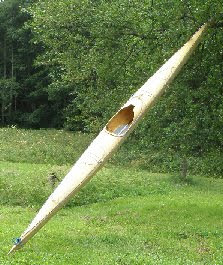
SeaStrip (6,20 x 0,38 meter) might be the narrowest kayak you have seen. Perhaps a more appropriate name is the "Needle". This comes to peoples mind when they see it.
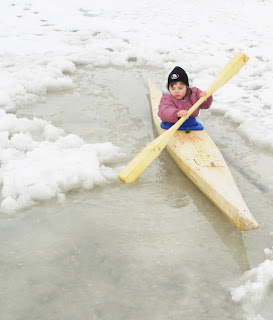
Alma's kayak is a kids kayak. Designed as a scaled down traditional kayak. Scaled down in order to facilitate comfortable paddling for small people, without common knowledge on how capable toddlers of 3 years are to maintain blance and or bracing with the paddle. With practical experience we would discourage parents to put pontoons on the sides of the kayak. Try rolling a kayak with side floats and when you're upside down you will know what I mean.
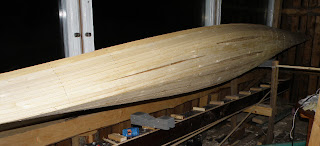
Imitating established designs is another challenge. How can photos of profiles and measures be used to build a similar kayak? You may recognise this halfbuilt kayak having some extra design strips of oak in the hull. Wood selection can be used to make harder chines than used in the printed forms that would strips are built on.
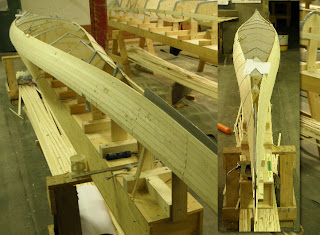
Once you have one design and know how it behaves next temptation will be to make adjustments. The two prictures below are of the fourth design originating from the previous imitation. Stern and bow have been narrowed down among other things. I would expect this kayak to be faster, dive and cut waves and to be less sensitive to sidewinds. It should be less bumpy in choppy waters.
 Especially the curvy shapes are admirable I've noticed. Dimensions of kayak building and custom designs is unlimited, so are also the possibilities to design and build something out of your scope of abilities.
Especially the curvy shapes are admirable I've noticed. Dimensions of kayak building and custom designs is unlimited, so are also the possibilities to design and build something out of your scope of abilities.
At the moment the third kayak is getting epoxied and fiberglassed while the fourth has the hull ready for sanding. When you have and excellent finnish of the basics in the hull it becomes tempting to do some inlay work, preferably something that falls in naturally with the wood grains. There is of course a limit on how much the strips allow bending.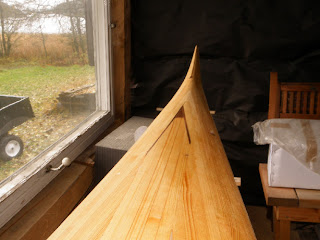
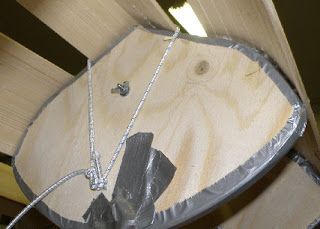 challenge. The sharp bow and stern bottom in combination with the flattish middle section requires a twist of the strips along the keelsection. At the same time sidestrips need to be bent sideways to carry down a the curvature of the shear down towards the keel.
challenge. The sharp bow and stern bottom in combination with the flattish middle section requires a twist of the strips along the keelsection. At the same time sidestrips need to be bent sideways to carry down a the curvature of the shear down towards the keel.  the form. Perhaps the problem would not have been there with stapled strips? Alternatively the strips could have been layed out differently? I do have a plan however - the keel section is still not fixed to the bow, so I can extend it forwards and push it back down and out. What may be interesting is to see the technique to keep strips aligned without staples, and to have them pressed together. All the complex forces cannot be fixed at this stage by stapling. The forces would only lift the staples up and out as they did in my attempt to fix the hoovering keelsection.
the form. Perhaps the problem would not have been there with stapled strips? Alternatively the strips could have been layed out differently? I do have a plan however - the keel section is still not fixed to the bow, so I can extend it forwards and push it back down and out. What may be interesting is to see the technique to keep strips aligned without staples, and to have them pressed together. All the complex forces cannot be fixed at this stage by stapling. The forces would only lift the staples up and out as they did in my attempt to fix the hoovering keelsection.




